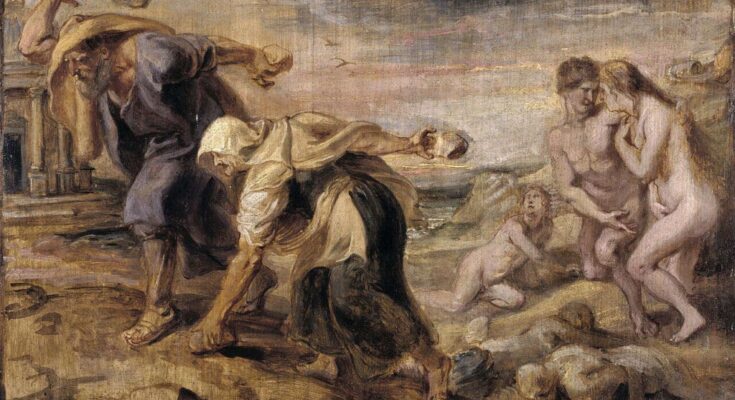
A flood myth is a story found in various civilizations about a world ending flood, usually brought about by a god or deities. According to such stories, the flood was a punishment for people’s misbehavior.
Some of these myths portray the flood as a means of washing away the old and making room for a new beginning.
Civilizations with a flood myth
The flood is frequently connected to stories of the world’s creation in which water is a mighty force. A hero usually survives the flood in many of these myths. This hero often represents the human desire to live and to begin anew.
There are many flood myths in various cultures throughout the world. In Greek mythology, the story of Deucalion and Pyrrha tells that story. In Hinduism, manvantara-sandhya refers to a flood. The Genesis flood narrative is a Hebrew flood myth.
Further still, the Cheyenne people have their own flood story, as do the people of ancient Mesopotamia. All of these cultures have the same theme of a great flood that alters or reshapes the world.
The flood myth of various civilizations
Deucalion and Pyrrha in Greek mythology
Greek mythology has a righteous couple named Deucalion and Pyrrha. Pyrrha was the devoted wife of Prometheus’s son Deucalion. They were known for the virtue and fairness and were the most just people in a chaotic and sinful world.
However, at this time, the gods, especially Zeus, were angry because of human greed and wicked deeds. Zeus decided to send a great flood to cleanse the earth and rid it of all life.
The Flood (Deucalion holding aloft his wife)
Paul Merwart (1855-1902) pic.twitter.com/RnPQYLT07M— Academia Aesthetics (@AcademiaAesthe1) December 4, 2022
Prometheus warned his son Deucalion of the disaster to come. Deucalion and Pyrrha quickly built a boat to live through the storm. They were safe in their vessel during the floodwaters that covered the Earth with everything else having been destroyed.
The flood ended after many days, and their boat stopped on Mount Parnassos. Hermes then visited them and ordered them to throw “their mother’s bones” over their shoulders. When they realized what “mother” meant, they threw stones behind them.
The stones turned to people—Deucalion’s turned to men, Pyrrha’s to women—and repopulated the earth. Then, Deucalion and Pyrrha became the leaders of the new human race.
Manvantara-sandhya in Hinduism
The story in the Hindu text Shatapatha Brahmana is similar to other flood myths. Rather than a god, a fish warns Manu, the lone survivor of an impending flood. The fish requests him to build a boat and tie the fish’s horn to the boat.
The fish guides the boat to a mountain when the flood arrives. When the flood subsides, only the human Manu remains, and he performs a sacrifice, out of which his wife is born from the water. They repopulate the earth together.
In Hinduism’s cosmology, there occur several floods known as manvantara-sandhya. A sandhya period consists of a flood and is the transition phase between two successive manvantaras—a period ruled by a Manu.
The earth is submerged for 1.7 million years until the following Manu recreates mankind. We are in the seventh manvantara, and there are fourteen manvantaras and fifteen floods.
Hebrew flood myth
In the Hebrew Genesis, Yahweh decides to flood the earth to cleanse humanity, which had become corrupted. He decides to save Noah and tells him to build an ark to save human and animal life.
A wise man is warned about a divine flood that will destroy the world, so he builds a boat for his family and all the animals. They survive and humanity starts again.
This is NOT the story of Noah's Ark.
It's the Akkadian story of Atrahasis, written 1,000 years before Genesis.… pic.twitter.com/DsyKvAvUlD
— The Cultural Tutor (@culturaltutor) September 26, 2023
Noah’s family and pairs of all animal species enter the ark, and, when the floodwaters rise, they are all that survives, as all life on the outside had perished. After the flood recedes, they leave the ark, and Yahweh promises never to flood the earth again. This promise is signified with a rainbow.



